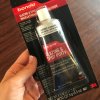CY343491
Active Member
- Joined
- Apr 5, 2023
- Messages
- 387
Hi,
When i started modelling i was using mr. dissolved putty, it doesn't fill large gaps and cures so slow, takes so much time when assembling, then i tried "mr. white putty R", it's not bad, but needs thinning all times and cures so quickly and a little bit expensive. I've found an alternative way, ordered an acrylic based wall filler in 200 ml tube tried on plastic model, worked great, it has ideal consistency, no need for thinning, ideal curing time, easy application, can be sanded easily, applicated brush can be cleaned with soapy water because it's acrylic based.
When i started modelling i was using mr. dissolved putty, it doesn't fill large gaps and cures so slow, takes so much time when assembling, then i tried "mr. white putty R", it's not bad, but needs thinning all times and cures so quickly and a little bit expensive. I've found an alternative way, ordered an acrylic based wall filler in 200 ml tube tried on plastic model, worked great, it has ideal consistency, no need for thinning, ideal curing time, easy application, can be sanded easily, applicated brush can be cleaned with soapy water because it's acrylic based.

